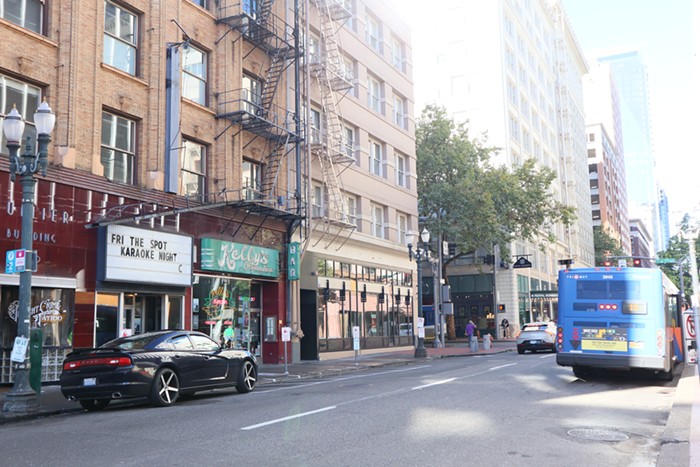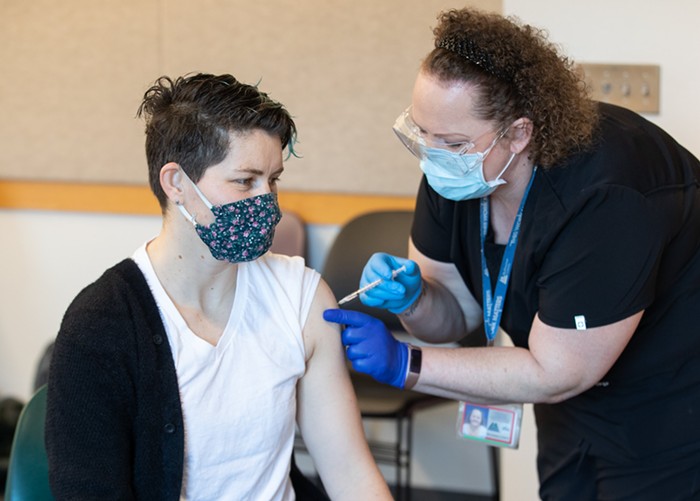ON MONDAY, MARCH 22, at 3:30 pm, Jack Dale Collins lay on the ground at Hoyt Arboretum, bleeding to death. Officer Jason Walters had just fired four shots into Collins, hitting an artery in his hip. Within minutes the man who lived, drank, and slept on Portland's streets for 20-plus years was dead.
It took 30 hours for the medical examiner and police to release the name of the man shot by Officer Walters. They had to fingerprint Collins' corpse to figure out who he was. The mug shot attached to the eventual press release including Collins' name is a grim portrait. His mouth is almost hidden beneath a bushy, wiry beard. Lines droop beneath his eyes, deep wrinkles are carved between his eyebrows. He is balding on the top of his head, with hair sprouting from his temples and around his ears like an impoverished monk. His gaze is intense.
"A PEACEFUL DRUNK"
I pulled Collins' mug shot out of my bag and showed it to James "Jimbo" Nelson, who was standing with a crowd fixing his bike trailer outside St. Francis Church on SE 11th and Oak, two days after the shooting. Nelson immediately identified the face.
"Old Man Jackie Collins," said Nelson. "I didn't know it was him the police shot."
Nelson does not look so different from Collins himself—bushy gray beard, deep wrinkles, rough skin. Both have lived on the street in Portland for two decades.
"He was like any other drinker down here, Old Man Jackie Collins," said Nelson. He leaned on the bike trailer. It was one of the first sunny, warm days of spring, and Nelson wore a black Harley-Davidson tank top. Nelson and his girlfriend, who goes by the name Gypsy Spirit, caravan around town on two bikes, hauling their homes behind them, trailed by their dog. Collins moved around town in much the same way, they said, but alone.
Nelson took Collins' mug shot and hurried off to another group of homeless people who hang outside St. Francis, shooting the shit and smoking cigarettes until the church's dining hall opens up for its daily free meal.
A lean woman named Momma Stormy knew Collins, knew him for years and still didn't know much about him. "He liked to go up to Washington Park a lot, just spend time up there. That's where a lot of drunks hang out and he would go up there to drink," said Stormy.
"He drank every day," said Nelson. "He was a drunk, but he was a peaceful drunk."
Collins first surfaces in police files in 1980. Thirty years of Collin's life show up in police reports as 25 incidents, including eight public park exclusions and nine citations for drinking in public.
In a write-up from an officer on horse patrol in Waterfront Park in 2005, Collins appears resigned to his life.
"[Collins] had a Seattle Best coffee cup sitting next to him. I rode up to [Collins] and asked what he was drinking," reads the report. "He said coffee. I asked him if I could check and he removed the lid from the coffee cup. I saw the contents and recognized it as beer. I asked him what type of beer it was and he said it was Milwaukee's Best. I asked him to pour it out in the bushes."
The horse patrol officer had to quantify Collins' appearance for the paperwork. He circled the words "thin," "dirty," "low-pitched voice," "medium complexion," and "teeth unknown."
SCARS
At 3:05 pm on March 22, someone called the police to report a "drunk transient" harassing people at Hoyt Arboretum. The transient was yelling at people, but he did not seem physically violent, the caller said. The transient was Collins.
Officer Jason Walters self-dispatched, heading out on the call alone. A 13-year-veteran of the bureau, Walters had worked around Washington Park for five years. He is also, Portland Police Association President Scott Westerman pointed out to press, a vegan bike rider. "He's very Portland," says Westerman.
Officer Walters was not carrying a beanbag gun, the bulky but non-lethal gun that gained recent controversy when Officer Chris Humphreys used one to shoot a 12-year-old girl resisting arrest at a MAX station in November 2009. Strapped to Walters' belt were a baton, pepper spray, a Taser, and a gun. As he left on the call, he phoned Hooper Detox for a van to come out to the arboretum and possibly pick up the drunken transient.
Hooper Detox is the city's sobering station and the first place addicts can go to get clean. It has 70 beds but can only afford the staff to fill 54. They also staff a van called CHIERS, which circles the city 24 hours a day, seven days a week. The van picks up 2,800 intoxicated individuals a year. This is actually a decrease. In the mid-1990s, the van picked up 3,200 people annually.
The CHIERS van never reached the arboretum. Everything happened too fast.
Officer Walters arrived at the arboretum office at 3:24 pm. The office is near the top of the park, by the big chapel-like gazebo that Zoobombers refer to as "the Skanktuary." Green potted plants surround the entrance and right outside the door are two single-room bathrooms.
The person who called 911 told Officer Walters that the drunken transient was in one of the bathrooms. Officer Walters, according to the official interview police investigators waited 48 hours to conduct, knocked on the door. Jackie Collins emerged. His face, neck, and hands were covered in blood. In one hand he held a knife with a six-inch handle and one-inch blade.
Medical Examiner Dr. Karen Gunson does not shy away from the grisly details. "He cut around his neck, deeper on the right side," says Gunson, describing Collins' body. "It's not likely that wound would have killed him. Though if he had kept cutting, down to his jugular maybe, he could have died."
Back at St. Francis, Nelson and Gypsy Spirit shake their heads when asked if they think Collins was trying to kill himself.
"I heard he was a cutter, that disease for cutting," says Nelson.
"He was a slicer," agrees Gypsy. "When he got into depression mode, when he was really drunk, he would go into a slashing mode where he'd cut himself. His arms. That's why he always wore long sleeves." She traced on her arms where she had seen his scars.
"Even in the summer, he wore long sleeves," says Nelson.
"He didn't want anyone to know about his life," says Gypsy. "He was a private man, a personal man."
"Cutting is an unusual symptom of mental illness," says Jason Renaud of Mental Health Association of Portland. "It's usually seen in young people, but can be seen in older people. It's a response to feeling bad about yourself, bad about your environment. It's hard to treat, people are usually pretty secretive about it. It's a way of harming yourself without killing yourself."
LAST DAYS
When the city tried to track down every homeless person in Portland for its one-night count on January 28, 2009, it found 1,591 people sleeping outside and 820 people in shelters. Despite the city being four years into its "10-Year Plan to End Homelessness," there were 13 percent more homeless people counted in Portland in 2009 than in 2007.
In a different in-depth count in 2008, 35 percent of homeless Portlanders reported or were observed to have a mental illness. Only 19 of the 646 interviewed in that count were over age 60.
Why are these people suffering from mental illness not living somewhere safe in treatment? Disability Rights Oregon Executive Director Bob Joondeph explains in five letters, "M-O-N-E-Y."
"We have an under-funded and overburdened community mental health system," says Joondeph. "We end up paying down the road in jails or emergency rooms, neither of which are designed to humanely deal with people with mental illness who are in crisis."
In the medical examiner's office, Dr. Gunson says she did not see any scars from cutting on Collins' arms. But, she admits, she wasn't looking for them. Though she believes Collins was trying to commit suicide in the arboretum bathroom, Dr. Gunson classified the death as homicide. "Homicide is just a technical term meaning killed by someone else," explains Dr. Gunson. "It's up to another person to decide whether that means murder or manslaughter."
A grand jury is due to convene about the incident this Thursday, April 1. It will decide whether the officer should be criminally charged.
When he emerged from the bathroom covered in blood, Collins moved toward Officer Walters, according to the officer's statement. Walters asked if Collins needed help. Collins did not respond. The officer backed up while telling Collins to drop the knife. Collins said he would not. According to his report, Officer Walters backed up against a "physical obstruction" and ordered Collins to drop the knife. Collins continued "advancing."
Walters pulled his gun and fired two shots into Collins. Collins spun around slowly, the knife still in his hand. Walters shouted again to drop the knife and Collins slowly approached him. Walters fired two more shots. Collins dropped to the ground, and as he bled, Walters called for medical support. The medical staff declared Collins dead at the scene. He was 58.
Though Officer Walters did not know it at the time, a second 911 call had come in to police about Jackie Collins that day. A mother and son had told a park ranger that Collins had shouted at them and threatened to kill them.
Days later, several media outlets broke news of another alarming detail, contained in a police report the bureau had initially classified as confidential.
Eleven days before he was shot, says the report, Collins went to the police to confess a crime. He walked into Central Precinct and told Officer M. John Holbrook that he had molested a girl 42 years ago. He couldn't remember her name. Or where she lived. He had not spoken to her since. But he wanted the police to know that he had "rubbed his penis on her vagina" one night in his parents' house.
"Talking with Collins was difficult as he took quite a while to respond to questions and had to be reminded periodically of the question," wrote Officer Holbrook. After the conversation, Holbrook directed Collins to get in touch with a mental health service.
One week after Collins was shot, there is no blood on the ground outside the arboretum office. The bathroom, though small and covered in ugly green tile, is clean.
OUT OF THE WAY
Nelson and his friends say Collins never stayed in one place for very long. He preferred to keep out of the way, not talk to people. "He hit all the free places around town that he could. He never kept one squat for more than a few days," says Nelson. Gypsy Spirit and Momma Stormy say he often slept under the St. Johns Bridge.
It's easy to see why Collins would like the park under the St. Johns Bridge. On the afternoon of Monday, March 29, the park was completely empty of people. Though the thunder of cars shook overheard, the grass was green and crisp. Geese meandered by the water's edge.
But underneath one wide pine tree near the edge of the park that day was another makeshift home. Someone else's wet red blanket hugged two backpacks and a shopping basket. Their 40 of malt liquor nestled against a cooking pan and a bundle of knives on the hard, dry earth.
An error has been changed in the online version of this article. The print edition says the police investigators took 36 hours to interview Officer Walters. They actually took 48 hours.



















